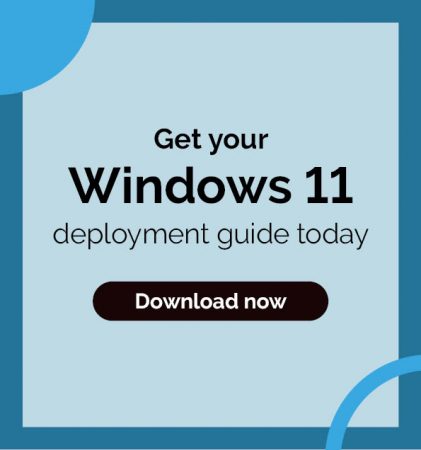Windows 10 End of Support: your options
4 minute read
Robert McMurdo
January 25th, 2024
There is just over a year until Windows 10 Enterprise and Education reaches End of Support (EOS). This may seem like a long time, but staying ahead of the curve is key to ensuring your organisation gets the most out of new technology.
Before Windows 10 EoS, you need to ensure that your infrastructure and processes are suitably modernised to retain both security and productivity for your end users. Without proper processes, workflows, and plans in place, this task can become overwhelming and unachievable. By taking an intuitive approach to modernising your technology, you will ensure the retainment of current business processes without sacrificing time, energy, and costs.
There are several options your organisation can take in line with Windows 10 EoS, all designed to make the transition as smooth as possible.
What does Windows 10 EoS mean for my organisation?
When Windows 10 reaches end of support, Microsoft will no longer provide bug fixes for issues, security fixes for vulnerabilities, time zone updates, or technical support for problems that might occur.
Version 22H2 is the final version of Windows 10. All editions of Windows 10 will remain in support with monthly security updates until 14th October 2025. Note that the Windows 10 IoT Enterprise Long-Term Servicing Channel (LTSC) and Windows 10 IoT Enterprise will continue to receive updates based on their specific lifecycles.
With the End of Support (EoS) for Windows 10 coming in less than two years, it is advisable to migrate to a modern OS. Running unsupported software that is no longer receiving security updates can leave your organisation vulnerable to significant security risks and potential compliance misalignments.
What are my options?
When a product reaches its end of support, almost always the next step is to upgrade to the latest edition of the product. In this case, updating to Windows 11 is the easiest and least disruptive next step after Windows 10 EoS.
Windows 11 is the most secure and productive Windows yet, having several new features designed to transform workplaces in almost every sector. In terms of making the transition, you have three core options:
- Upgrade eligible devices to Windows 11 using your tooling/ approach of choice
- Purchase new Windows 11 devices, leveraging modern provisioning through Windows Autopilot
- Migrate to Cloud PCs with Windows 365 to make Windows 11 available to users on any device
Refresh to new Windows 11 devices
Microsoft’s most updated devices are innately accessible, user-friendly, and secure. Built for the user experience, Windows 11 devices are next level.
If you wish to upgrade to Windows 11 by updating your devices, you must determine the readiness and eligibility of your current devices, checking that they all meet the hardware requirements and can be upgraded to Windows 11. This can be done through your existing management tooling, with support from Windows 11 specialists .
For devices that aren’t eligible for Windows 11, or older devices due for a refresh, now is the time to transition to new devices running Windows 11. New modern devices from partners like Dell, HP, Lenovo, and Surface and the rest of the Windows ecosystem offer a wide range of options to suit different end user needs.
Migrate to Windows 11 in the cloud with Windows 365
On your journey to modernising your endpoint estate, you can move end users with Windows 10 devices to Windows 11 in the cloud using Windows 365. This ensures all employees will receive every Windows 11 security update, as well as opening new ways of working.
Microsoft have announced that Windows 365 subscriptions will include Extended Security Updates (ESUs) at no additional cost for Windows 10 devices that access Windows 365. This new option gives you the flexibility to continue using older Windows 10 devices for longer, supporting both cost and sustainability goals, through extending the life of these devices for an additional three years.
Windows 365 recently made a new service option generally available for frontline and shift workers. If workers don’t use a dedicated personal computer, but rather use a device that is shared or an older device, they can access Windows 11 using Windows 365.
Extended Security Updates (ESU’s) for Windows 10
Moving to Windows 11 is the widely recommended next step once Windows 10 reaches EoS, but this can be difficult for some organisations due to budgets, compliance, and guidelines. Therefore, Microsoft have announced they will offer Extended Security Updates (ESU’s) on Windows 10.
Like the Windows 7 ESU programme, organisations will be able to purchase a yearly subscription to security updates. The yearly commitment is renewable for three years. Devices enrolled in ESUs will receive monthly security updates to keep these Windows 10 devices secure.
The ESU programme for Windows 10 will include critical security updates. ESUs do not include new features, customer-requested non-security updates, or design change requests. Technical support beyond the ESU itself is also not available. Some important points to note:
- For Windows 365 customers, ESUs will be provided for the Windows 10 devices that connect to a Cloud PC running Windows 11 at no additional cost
- If you run a Windows 10 instance in Azure Virtual Desktop, ESUs will also be available at no additional charge on those virtual machines (consumption not included)
- The pricing for Windows 10 Extended Security Updates (ESU) has not been announced yet. However, it is expected to be similar to the Windows 7 ESU programme
Ensure Windows 11 ReadinessTo further explore Windows 11 deployment for your organisation, fill out the form linked below to download the Windows 11 Readiness Assessment.
|


Talk to our Modern Workplace team
If you are interested in finding out more about how your organisation will benefit from Windows 11 book your free one-to-one call with one of our specialists by using the booking form below.
Alternatively, please email us at [email protected] or call 01904 562200 and one of our specialists will be in touch to discuss your requirements.
Book a call

